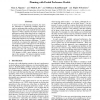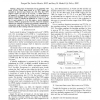493 search results - page 18 / 99 » Representing preferences using intervals |
CP
2005
Springer
14 years 1 months ago
2005
Springer
The aggregation of individuals’ preferences into a single group outcome is both well-studied and fundamental within decision theory. Historically, though, a pervasive simplifica...
CORR
2011
Springer
13 years 2 months ago
2011
Springer
In many real-world planning scenarios, the users are interested in optimizing multiple objectives (such as makespan and execution cost), but are unable to express their exact trad...
FUZZIEEE
2007
IEEE
13 years 11 months ago
2007
IEEE
Fuzzy logic is frequently used in computing with words (CWW). When input words to a CWW engine are modeled by interval type-2 fuzzy sets (IT2 FSs), the CWW engine's output can...
OOPSLA
2010
Springer
13 years 6 months ago
2010
Springer
We introduce a type system based on intervals, objects representing the time in which a block of code will execute. The type system can verify time-based properties such as when a...
ICLP
2005
Springer
14 years 1 months ago
2005
Springer
Abstract. Constraints and preferences are ubiquitous in real-life. Moreover, preferences can be of many kinds: qualitative, quantitative, conditional, positive or negative, to name...


